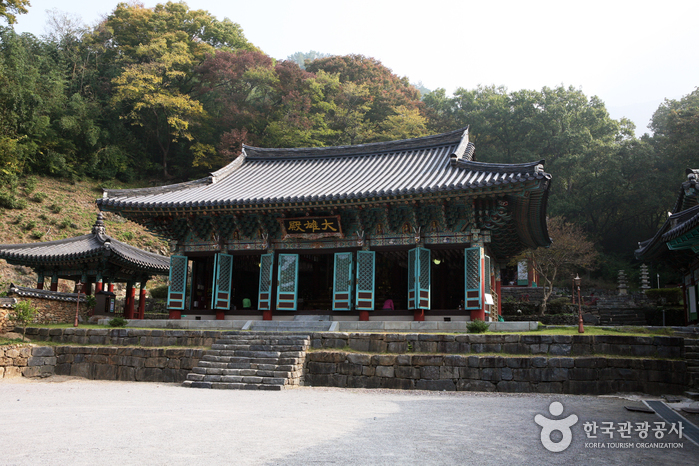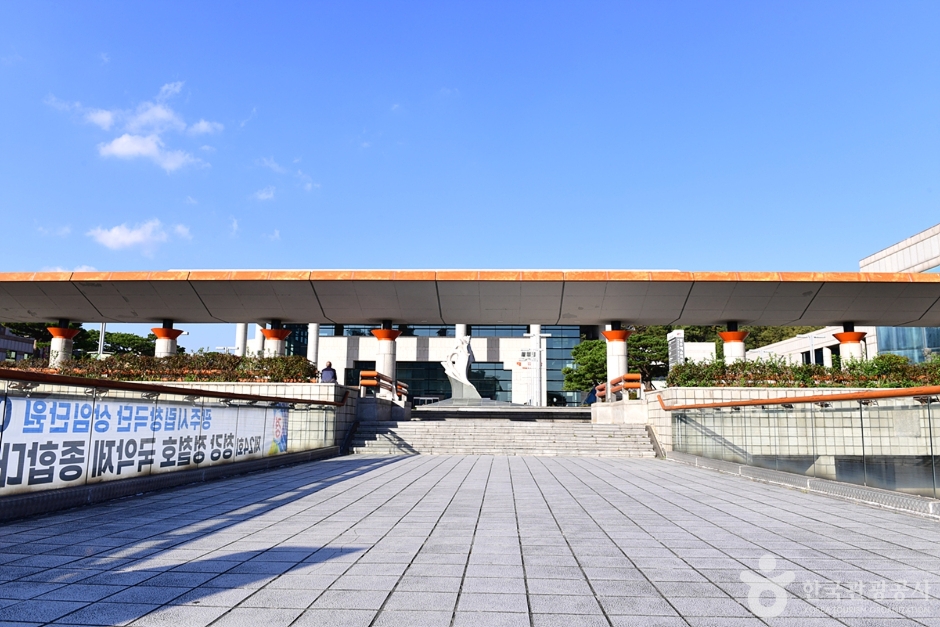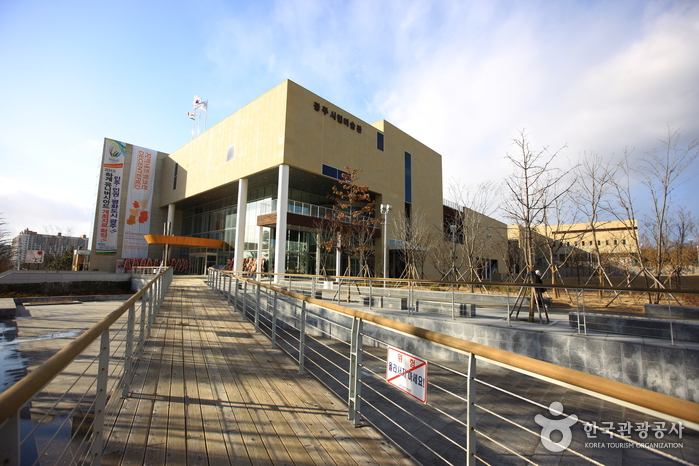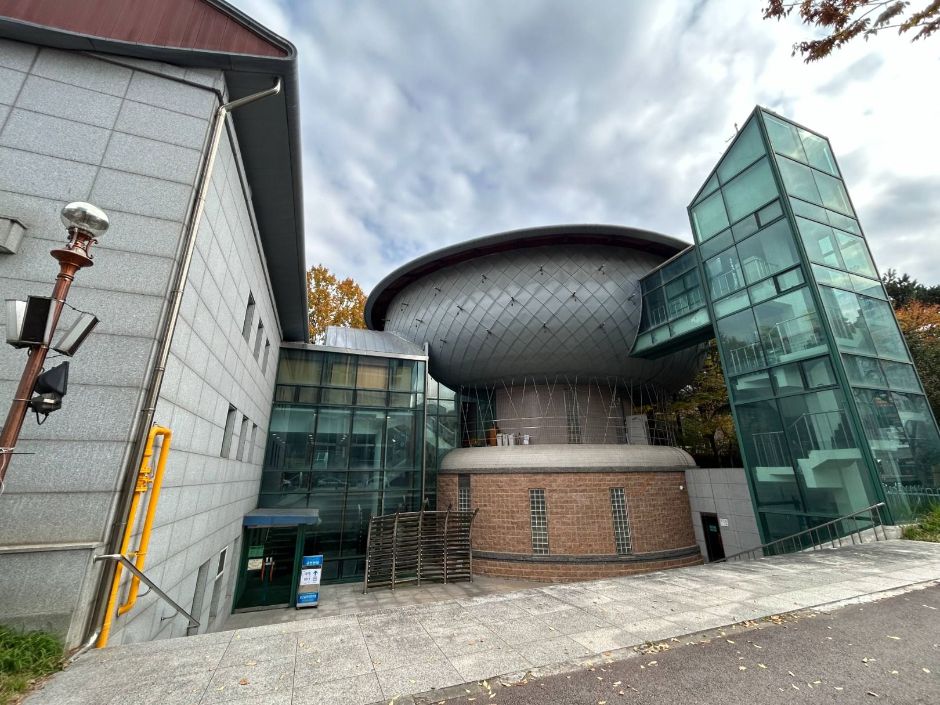Gwangju Jeungsimsa Temple (증심사(광주))
4.8Km 2021-11-09
177, Jeungsimsa-gil, Dong-gu, Gwangju
+82-62-226-0108
Located on the western foothills of Mudeungsan Mountain, Jeungsimsa Temple is a representative temple of Gwangju. First founded by Buddhist monk Cheolgamseonsa Do Yun in 517 (Silla Kingdom), the temple was remodeled by Buddhist monk Hyesoguksa in 1094 (Goryeo dynasty) and again by Kim Bang in 1443 (Joseon dynasty). The temple was burned down during the Imjin War and was reconstructed in 1609 by three Buddhist monks: Seokgyeong, Sujang, and Dogwang. It underwent several additional restorations before being destroyed again by fire during the Korean War. Most of the existing buildings, including Daeungjeon Halll (main temple building), were rebuilt in the 1970s.
Gwangju Arts Center (광주예술의전당)
4.8Km 2024-11-18
60 Bungmun-daero, Buk-gu, Gwangju
Opened in 1991, the Gwangju Arts Center is the cornerstone of culture and arts in Gwangju. It offers high-quality performances and exhibitions across various genres, including Korean traditional music, opera, classical music, and ballet. The center boasts a range of artistic facilities, such as a main theater, a secondary theater, a traditional music hall, a sculpture garden, and an amphitheater. The main theater has a seating capacity for up to 1,500 people.
Olive Young - Gwangju Maegok Branch [Tax Refund Shop] (올리브영 광주매곡)
4.9Km 2024-04-18
319, Seoljuk-ro, Buk-gu, Gwangju
-
Jungoe Park (중외공원)
5.0Km 2021-10-25
52, Haseo-ro, Buk-gu, Gwangju
+82-62-613-7100
Jungoe Park is one of the nation's most famous leisure spaces. There is a children's grand park, the Olympic Garden, and the Olympic Monument. The children's grand park is especially popular on weekends and holidays.
There is also a folk museum, an education center, and the Biennale Exhibition Hall in the Biennale & Museum section of the park.
The park is most popular during fall for its beautiful foliage. In addition, the Rainbow Bridge is a symbol of the Biennale and was installed during the 1st Gwangju Biennale.
Gwangju Museum of Art (광주시립미술관)
5.0Km 2022-09-02
52, Haseo-ro, Buk-gu, Gwangju
+82-62-613-7100
The Gwangju Museum of Art was founded on August 1, 1992, to promote local artists. In 1996, it served as the venue for the Gwangju Biennale. The museum holds over 560 works, including those from Heo Baekryeon, Oh Jiho, Yang Su-ah, and Im Jik-sun, all local artists. In addition to the permanent exhibitions, the museum also has special planned exhibitions and other cultural programs.
Chungjangsa Shrine (충장사)
5.4Km 2023-01-25
13, Songgang-ro, Buk-gu, Gwangju
+82-62-613-5407
When you reach Baejae along the tourist road leading up to Wonhyosa Temple, you can see the well-maintained tomb and the magnificent building of Chungjangsa Shrine on the left. It was built in 1975 as a memorial to General Kim Deok-ryeong, born in Mudeungsan Mountain. In the precincts, there are the shrine, where Kim Deok-ryeong's portrait and command paper are enshrined; the east room and west room; Eullyun Monument and Commentary Monument, the relics hall; Chungyongmun Gate; and Ikomun Gate. In the relics hall, the clothes of 'General Kim Deok-ryeong,' designated as Important Folk Material, and the coffin excavated from the general's tomb, as well as his handwriting, are on display. On the hill behind the shrine is Kim Deok-ryeong's tomb and tombstone, as well as his family's tomb.
Jin Convalescent Hospital (진요양병원)
5.5Km 2025-10-23
33, Daejasil-ro, Buk-gu, Gwangju
Jin Convalescent Hospital is a Ministry of Health and Welfare-certified cancer rehabilitation hospital located in Unam-dong, Buk-gu, Gwangju. We provide personalized care tailored to each patient’s condition and symptoms, focusing on specialized programs for cancer patients while utilizing the latest equipment and technology. Our commitment is to prioritize patients’ health and wellness. In 2024, we were designated a foreigner-friendly hospital in Gwangju, offering internal medicine consultation, a wellness clinic, comprehensive blood tests, obesity treatments, and an integrated pain clinic combining Western and Korean medicine for international patients. Experience compassionate, patient-centered care and expert medical treatment here with us.
Olive Young - Gwangju 518 Park Branch [Tax Refund Shop] (올리브영 광주518공원)
5.6Km 2024-04-18
90, Sangmuminju-ro, Seo-gu, Gwangju
-
Gwangju National Museum (국립광주박물관)
5.7Km 2023-11-28
110 Haseo-ro, Buk-gu, Gwangju
+82-62-570-7000
Gwangju National Museum, opened on December 6, 1978, was established to promote the development of cultural arts and to foster patriotism. Gwangju National Museum’s goal is to conserve cultural values through the collection and preservation of historical and valuable artifacts found in the Gwangju and Jeollanam-do regions as well as make contributions to the community through continuous research, exhibition, and education. With over 130,000 artifacts as well as various educational and experience programs, the museum aims to provide an enjoyable cultural center for visitors.
Bitgoeul Korea Traditional Classical Music Instruction Hall (빛고을국악전수관)
5.7Km 2024-12-17
182 Punggeum-ro, Seo-gu, Gwangju
Bitgoeul Korea Traditional Classical Music Instruction Hall offers various programs throughout the year. Since 2002, classes on traditional instruments are available, as well as separate children gugak classes. Special exhibition on the second floor has various instruments that visitors can actually try. The permanent exhibition on the third floor has 45 different gugak instruments as well as videos to further provide detailed information. The main area is the performance hall on B1-B2F, with 137 seats, that offers performances every Thursday for free from traditional gugak to fusion music.


![Olive Young - Gwangju Maegok Branch [Tax Refund Shop] (올리브영 광주매곡)](http://tong.visitkorea.or.kr/cms/resource/19/2886819_image2_1.jpg)


![Olive Young - Gwangju 518 Park Branch [Tax Refund Shop] (올리브영 광주518공원)](http://tong.visitkorea.or.kr/cms/resource/24/2886924_image2_1.jpg)

 English
English
 한국어
한국어 日本語
日本語 中文(简体)
中文(简体) Deutsch
Deutsch Français
Français Español
Español Русский
Русский